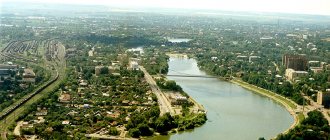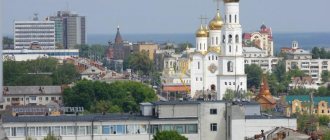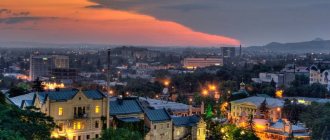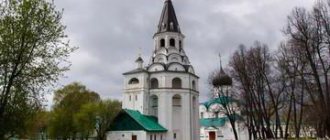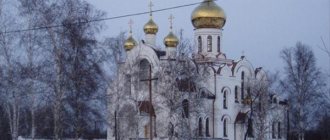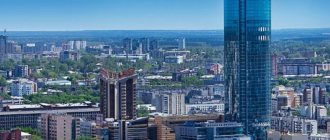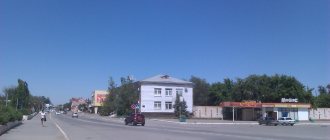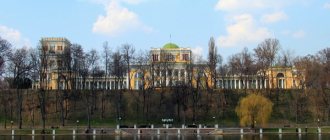Bezhetsk is a small town in the Tver region, the administrative center of the Bezhetsk district. Its population at the beginning of 2021 was about 22,000 people. It is located northeast of Tver on the western spurs of the Bezhetsky Verkh hill on the right bank of the Mologa River near the confluence of the Ostrechina River. The Pokhvala River also flows through the city.
Bezhetsk has a long history
The name “Bezhetsk” probably comes from “bezh” - refugees, fugitives. According to legend, the village of Bezhichi was founded by refugees from Novgorod.
The village of Bezhichi, located 20 km north of the modern city, is mentioned in the Novgorod chronicle since 1137 as Bezhetsky Verkh - the center of the Bezhetsk Pyatina of the Novgorod land, although archaeological finds suggest that it arose much earlier. The village was devastated in 1272 by the Tver prince Svyatoslav Yaroslavich, after which the center of the region was moved to the Gorodetsk fortress on the site of modern Bezhetsk.
At the end of the 14th century, it became part of the Moscow Principality, and in 1433 it found its own prince - Dmitry Yuryevich the Red, grandson of Dmitry Donskoy. Mentioned in the chronicle “List of Russian cities near and far.” Until 1766 it was called Gorodetsk; it became a city in 1775. From 1796 (until 1929) - the center of the Bezhetsk district of the Tver province. In 1876, a railway passed through the city; at the end of the 19th century, the city was a major flax trading center. In 1929, the city became the center of the Bezhetsky district and the Bezhetsky district of the Moscow region. In 1935-1990 - a city of regional subordination and the center of the Kalinin region district.
.
In the 13th century, the Bezhetsky region was subjected to devastating raids by Tatar hordes. Tradition says that in the village of Alabuzin in the winter of 1238 there was a camp of Khan Batu. The region was also subjected to raids by Lithuanian conquerors. The chronicle tells about it this way: “Lithuania was at war near Torzhok and Bezhitsa, and the Novotorzhians with Prince Yaroslav Vladimirovich chased after them and fought with them.”
But it was not only hordes of foreign enslavers who ravaged the local region. The internecine wars of the princes of Tver, Novgorod and Moscow also caused damage to it. So, in 1272, as a result of the raid of the Tver prince Svyatoslav Yaroslavich, Bezhichi was defeated and turned into a pile of ruins.
In the 14th century, another settlement became the center of the region - the Gorodetsko fortress, located on the high steep banks of Mologa and Pokhvala, later called Badov Stream. Protected from the north by deep ravines and from the east by impenetrable swampy forest, the fortress was safer for the stay of the governor of Novgorod.
The Novgorod princes wanted to maintain their power over the refugee lands at all costs. They were attracted here by loamy soils suitable for growing flax, many rivers and lakes rich in fish, and dense forests in which there were many animals. Important trade routes from Novgorod to Persia, Turkey, and Bulgaria passed through the refugee lands.
In 1332, Moscow prince Ivan Kalita captured the refugee lands, but Veliky Novgorod bought them back. In 1397, the Bezhetsk region finally came into the possession of the Moscow princes. They did not conduct extensive trade, like the Novgorodians, and the importance of the region - the main supplier of fish, furs and other goods - fell sharply. His lands during this period belonged to princes and boyars, and later to monasteries.
Gorodetsko was not much different from an ordinary village. All buildings were wooden. Only in 1680 did the first stone building appear - the bell tower of the Vvedensky Monastery. It has survived to this day and is registered with the state as a monument to ancient Russian tent architecture.
In 1766 Gorodetsko was renamed Bezhetsk. In “Topographic News of the Academy of Sciences for 1772” it is said about the then city that it “was built on one right side of Mologa. It was formerly fenced with a wooden wall, ditches on two sides, a deep stream on the third, and the bank of the Mologa River on the fourth. The measures contained 460 fathoms in circumference, but now the walls have rotted and the ditches have swollen. Inside the city there are two parishes and churches, and two wooden ones.”
In 1777, the first schools appeared in Bezhetsk: theological - for the children of the clergy and primary - for the children of merchants and wealthy townspeople. The city had seven drinking houses, 152 shops, a windmill; two wax factories, a malt factory and four brick factories constituted its industry.
In the second half of the 18th century, a new part of the city emerged - the Invalid Side. The difficult military service that lasted a quarter of a century turned many recruits into invalids. Disabled soldiers who had completed their service found refuge in monasteries. By decree of Catherine II, monasteries were released from the obligation to support disabled people, and land plots began to be allocated from small towns for their settlement. 200 disabled people were assigned to Bezhetsk. They lived in barracks. The settlement had its own department of disabled officers, its own headquarters. Since then, the name Headquarters has been assigned to this part of the city.
In 1876, a railroad passed through the city. It revived trade and boosted the economy. From Bezhetsk to St. Petersburg, to the cities of the Volga region and abroad, agricultural products began to be sent by rail, and above all the famous Bezhet flax. Representatives of trading companies from France, England, and Germany appeared in the city. Bezhetsk is turning into a center of trade for a number of neighboring counties.
Small enterprises for processing agricultural raw materials, several brick factories and wine factories - that’s all the industry that existed in the city at the beginning of the 20th century. A quarter of the population of the county was engaged in local and waste trade in order to somehow make ends meet and feed themselves.
The news of the victory of the socialist revolution came to Bezhetsk on October 27, 1917. However, the zemstvo government, which was in the hands of the Mensheviks and Socialist Revolutionaries, stubbornly resisted the establishment of Soviet power in the city and district. The final transfer of power into the hands of the Soviets occurred only on December 15, 1917. A bureau of the Bolshevik Party was organized, headed by administrative commissar Pyotr Filippovich Skvortsov. The bureau included B.P. Machulsky-Kisel, P.F. Fedorov, N.S. Gusarov, D.I. Loginov and other active participants in the establishment of Soviet power. On behalf of the bureau, P. F. Skvortsov organized a detachment of the Red Guard.
The IV Extraordinary District Congress of Soviets, which opened on January 20, 1918, decided to put an end to the subversive work of the zemstvo government. A delegation led by Skvortsov was sent to the zemstvo congress. Skvortsov's speech was interrupted by insulting shouts and shots were fired. Skvortsov was villainously killed, and the counter-revolutionaries, fearing just punishment, cowardly fled. The city's communists had to wage a brutal struggle against anarchists, kulaks and deserters.
In July 1918, a new composition of the district executive committee was elected, which included M. S. Chudov, D. I. Loginov, V. A. Alekseev and others. On January 5, 1919, the first issue of the newspaper, called “Revolutionary Banner,” was published in Bezhetsk. In honor of the fighters for the people's happiness who died during the revolution, an obelisk was erected on May 1 Square.
During the years of Soviet power, Bezhetsk turned into a city with developed industry and agriculture. A mechanical plant was created on the basis of small weapons workshops, producing auto repair equipment and consumer goods. In 1927, at the All-Union Exhibition, the plant was awarded a gold medal for the production of high-quality instruments. In 1929-1930 The mechanical plant carried out an honorable order for the production of spare parts for tractors produced by the Putilov plant. In those years, new buildings rose in the wetlands. Since 1933, after reconstruction, the plant began to produce auto garage equipment and devices, receiving a new name - “Garo”.
In 1945, on a vacant lot called Shelomen, the buildings of Bezhetskselmash grew up. This is the only enterprise in our country that produces flax harvesters, flax hoe and other machines necessary for the comprehensive mechanization of flax growing. Equipped with high-performance equipment, the plant is the largest in the city. Machines manufactured in Bezhetsk work not only in the fields of our country, but also in Czechoslovakia, Poland, Bulgaria and other countries.
In 1963: at the international Leipzig fair, the LK-4M flax harvester was awarded a gold medal and a 1st degree diploma. In 1966, at the International Exhibition of Modern Machines in Moscow, the plant's products were awarded four gold medals for their high scientific and technical level, originality of solution and efficiency in production and operation. The flax pulverizer produced by the Bezhetsky plant was awarded the State Quality Mark.
Near the enterprise a whole city has grown up with bright multi-storey buildings, schools, dispensaries, a hospital, a Palace of Culture, and shops.
A garment factory, a meat processing plant, a reinforced concrete structures plant, a pilot plant and a mechanical repair plant were built in Bezhetsk. The products of the pilot plant greatly contribute to the mechanization of production processes at such giants of domestic agricultural engineering as the Chelyabinsk, Volgograd, Minsk and Lipetsk tractor plants.
Currently, Bezhetsk has many historical and cultural attractions, architectural sites, and Orthodox churches. Tourists and guests of the city should definitely visit its attractions.
House of Merchants Andreevs
The owners of this ancient mansion in the nineteenth century were the merchant of the first guild Vasily Andreev and his wife Sophia, who was of noble origin, and her ancestors were representatives of a noble family. Their son Vasily, who was the only child in the family, also became a merchant of the first guild. In addition, he was a trustee of the main hospital of Bezhetsk.
The house itself is built of logs, and the semi-basement is made of bricks. This is a two-story building with a large balcony on the street side. The facade of the house is superbly decorated, and its friezes are decorated with exquisite carvings. The house has historical and architectural value.
Location: Bolshaya street - 15/36.
House of the Korovkin merchants
The two-story house, which now houses the district executive committee, at the beginning of the twentieth century belonged to the merchant Sergei Korovkin and his family. It was built in 1900. The Korovkins were very wealthy people, and since 1914 they became the richest residents of Bezhetsk. They made a significant contribution to the development of public education, industry, trade, the city's healthcare system and the city's economy. They owned industrial enterprises of Bezhetsk.
The Korovkins were actively involved in social work and spared no expense in charity work. Sergei Korovkin financed the construction of the school and was a trustee of the girls' gymnasium. He also served as the head of the city and made a great contribution to its development.
Location: The intersection of Bolshaya Street and Rozhdestvensky Lane.
How to get there
By train: Bezhetsk is located on the Sonkovo-Bologoe railway line, so you can travel by train from Moscow or St. Petersburg to the Bologoe station, famous in the song “Merry Fellows,” on any of the many trains connecting the two capitals, and from there follow to Bezhetsk.
By bus: routes Bezhetsk - Tver (130 km, 6 flights per day), this is the most convenient option; Bezhetsk - Kashin (86 km, three times a week); Bezhetsk - Sonkovo - Tver (160.5 km, five times a week).
Geography
Bezhetsk is a pretty county town in the Central Federal District of Russia, in the northeast of the Tver region, located 126 km from the regional center. Bezhetsk, like other ancient Russian cities, stands on a river, and not even just one - it is crossed from south to north by the Mologa River, right in the city itself the Ostrechina River flows into it, and nearby, also within the city, another river flows - Praise. Such an abundance of water is a characteristic phenomenon for the most lake and river region of the Russian Center. After all, it is in the Tver region that three great rivers of the country originate - the Volga, Western Dvina and Dnieper. Bezhetsk is also known for being the coldest city in an already not the warmest region of Russia. For example, in 2012, the lowest air temperature in the Central Federal District of the country was recorded here. And yet, despite such a “cold reception”, it is worth visiting.
House of the Nevorotin merchants
This two-story mansion was erected in the early years of the twentieth century. It belonged to the Nevorotin merchants, one of the most prosperous residents of Bezhetsk. In its architectural style it is close to Moscow early modernism. The main entrance to the mansion is decorated with a portico.
The porch is framed by four columns: two rectangular columns and two Doric columns. The granite porch used to have 3 approaches . Above the portico there is a balcony and statues of Atlanteans, which are not only magnificent aesthetic elements, but also act as supports for the cornice. Particularly impressive in the interior decoration of the house are such interior components that have survived to this day, such as elements decorated with paintings, stucco moldings and embossed leather.
Location: Bolshaya street.
Merchants' mansions
The house of the Andreev merchant family is a beautiful two-story log building with a brick semi-basement. The house has architectural value and historical significance. The owner of the mansion was a merchant of the first guild and the chief trustee of the city hospital.
The house at the intersection of Rozhdestvensky Lane and Bolshaya Street, which housed the district executive committee in the last century, belonged to the Korovkin family at the beginning of that same century. These fairly wealthy people (in 1917 they were even recognized as the richest townspeople) made an invaluable contribution to the development of industry, the development of trade, the education and health care systems of Bezhetsk.
A landmark in the Moscow early Art Nouveau style on Bolshaya Street is the former mansion of the merchant Nevorotin. Tourists are captivated not only by the Atlanteans “holding” the cornice, but also by the interior decoration with perfectly preserved elements, decorated with embossed leather, exquisite stucco and painting.
The house of the merchant Revyakin, built according to a regular plan at the end of the 18th century, is the oldest surviving one. Although rebuilt several times. In the second half of the 19th century, the city society bought it from the merchant. As a result, a bank, city government, orphanage, city school and fire department could be located here. Later, the tower attached to the house was lost during Soviet times.
The house of tradesman Tyranov is also unique in its kind. It was built in the style of late classicism. At the end of the 19th century, the three-story stone building passed into the hands of the wife of merchant Krylov, and in the first decade of the last century, the city’s first cinema hall was inaugurated on the third floor.
House of notary Tugarinov
The building, built in the first years of the twentieth century, was formerly the apartment building of V.I. Tugarinova. This is a two-story mansion of a rectangular shape with a sloping corner in its southeastern part. Above the porch you can see the front raised part of the attic (the auditorium), shaped like a rhinoceros horn. Hence its second name: “Rhinoceros House”. The attic is crowned with a preserved spire (previously there were two spiers, the second was located above the balcony).
The walls of the house have cladding oriented diagonally. The windows of the house are decorated with carved frames. The door is also framed with carvings. The architectural design of the building combines eclecticism and modernity.
Annunciation Monastery
The first stone building of the monastery was erected in 1878. It was a building for the abbots of the monastery with a house church in honor of Saints Cosmas and Daniel. After 11 years, the construction of the Annunciation Cathedral was completed. There were two more churches nearby. The ensemble of the monastery was completely formed by the beginning of the twentieth century.
The monastery suffered greatly during the years of Soviet power. Unfortunately, many buildings have not survived to this day. But in recent years, the life of the monastery began to revive again.
Location: Leo Tolstoy.
Church of the Exaltation of the Cross
It is the center of spiritual life and an architectural monument of Bezhetsk from the mid-seventeenth century. Historians believe that the church was built in 1670 on the territory of a convent, and the construction of the stone bell tower was completed in 1782. This makes it the oldest building in the city that has survived to this day.
The church is the only building that has been preserved from the Holy Cross Monastery that was previously located here. The temple has a three-tier bell tower in the style of the early Baroque period. Its external design features extra-ordinary pilasters and majestic columns. In the interior of the church you can see wall paintings from the second half of the nineteenth century, preserved in excellent condition.
In 1937, by order of the authorities, the temple was closed. Worship services here resumed again in 1991.
Location: Red Square.
Children's music school
On Sovetskaya Square in the city of Bezhetsk, Tver Region, a landmark with a rather interesting history welcomes tourists. This is the building in which today the secondary school operates. A.P. Ivanov, where, in addition to basic subjects, musical wisdom is studied in depth, and the Children's Music School of Russian Instrumental Art. But the building itself is interesting here. This is the former Church of St. John the Evangelist, built in 1869 in a style close to Russian-Byzantine. According to local legends, the first temple that arose on this site was built by Dmitry the Red, the grandson of Dmitry Donskoy.
Transfiguration Church
The church was erected in 1772 on the territory of the abolished monastery. In its architectural appearance, elements of two styles can be distinguished: baroque and eclecticism. There are two temples here, surrounded by one fence. The main one is the Transfiguration Church. The Church of the Transfiguration has a somewhat deliberately rough appearance, while the Church of the Intercession stands out for the severity and asceticism of its facades.
Location: K. Chernyshev Square - 31.
Spaso-Cemetery Church
The amazingly beautiful temple was erected in 1787. During the Soviet years, the church was the only one functioning. Here you can still see ancient, well-preserved icons and a cypress altar. In the cemetery next to the church, relatives of Nikolai Gumilyov and the local writer Shishkov are buried.
Bell tower of the Vvedensky Monastery
This is the only surviving element of the ancient monastery, which was founded in the fifteenth century by the Monk Nektariy Bezhetsky. From the chronicles that have reached us, it is known that the widow of Ivan the Terrible, nun Martha, donated the icon of the martyr Uar to the monastery in memory of the tragically deceased Tsarevich Dmitry, who was her son. His birthday fell on the same date as the saint's feast day. The monastery existed until 1764, then a parish church was located on its territory.
The bell tower was probably erected in the early nineteenth century. It consists of two tiers and has 3 rows of rumors. At its top there is a scaly poppy on which a cross is mounted.
Location: Vvedenskaya street - 31.
History paragraph
The name "Bezhetsk", as historians believe, comes from the word "bezh", that is, refugees, fugitives. According to legend, the village on the site of the future city was founded by refugees from the troubled Novgorod, torn apart by political struggle, and therefore received the name Bezhichi. It is mentioned in the chronicle as Bezhetsky Verkh.
Novgorod, as you know, was divided into five districts - Pyatyn. The center of one of these pyatinas was precisely the village of Bezhetsky Verkh, although archaeological finds make it possible to push back the date of the appearance of the settlement here much further than the 12th century.
The rich, prosperous trading village was devastated in 1272, during one of the Horde “armies,” and the center of Pyatina moved to Gorodetsk, a fortress on the site of the modern city of Bezhetsk.
The expansion and strengthening of Moscow played a big role in the further history of Bezhetsk: at the end of the 14th century, Gorodetsk became part of the Moscow Principality, and later it had its own prince - the grandson of Dmitry Donskoy, Dmitry Yuryevich Krasny. It acquired city status in 1775 under Catherine II, during her administrative reform, and at the same time it was given the name Bezhetsk. Under Paul I it became the center of Bezhetsk district. In 1876, a railway line was laid here, which ensured the prosperity of the city, which by that time had become a major flax trading center.
Literary Memorial and Local History Museum
The museum complex is located in two buildings. In one of them there is a museum of V.Ya Shishkov , and in the other - a museum of V.V. Andreeva .
The Shishkov Museum is located in the building of a former school. It was opened on the occasion of the writer’s centenary. The museum's exhibition is dedicated to his work. Here you can familiarize yourself with the writer’s documents and manuscripts, his letters and photographs. Since 1980, exhibitions have been open to introduce museum visitors to the economy and life of local peasants at the turn of the nineteenth and twentieth centuries and the birds of the Tver region, stuffed which are presented here.
In 1986, in honor of the 125th anniversary of V.V. Andreev, a museum dedicated to this outstanding musician and founder of the Great Russian Orchestra has been opened. Its exhibition includes personal belongings of the musician, documents, music books, records with musical recordings and concert posters. The museum also features a permanent exhibition of folk instruments, introducing visitors to domras and balalaikas made by the best masters of their craft. Some of the exhibits are dedicated to refugee musicians and musical culture in general.
Location: Karl Marx street - 63.
Refugees from Novgorod
There is an opinion that it was they who founded the settlement of Bezhichi, which eventually became the city of Bezhetsk. Its geographical location is very favorable: the city is located on the right bank of the Mologa River at the confluence of the Ostrechina River.
At the beginning of last year, there were 22,000 indigenous people in the city.
The history of Bezhetsk is quite long. It was first mentioned in chronicles back in 1127, but it received city status only in 1775.
The city is the small homeland of famous Russian artists A. Samokhvalov and P. Chistyakov, the founder of the first Russian folk instrument orchestra - V. Andreev, writer V. Shishkov and many others who glorified Russia.
The modern attractions of Bezhetsk, see photos below, attract a large number of guests to the city. Especially popular are the Raspberry Museum, opened in 2010, and the Monument to the original Russian instrument, the balalaika. What else is interesting here for curious tourists?
Raspberry Museum
The Raspberry Museum was opened in Bezhetsk quite recently. This happened in 2010. By visiting this amazing museum, you can learn many interesting and curious facts about this beloved berry, get useful information about the methods of growing raspberries and the secrets of obtaining their high yield.
The Raspberry Museum was not founded in Bezhetsk by chance. The city's coat of arms, approved by Catherine the Second, depicts a raspberry bush on a silver field. All visitors will be treated to a pleasant surprise in the form of raspberry jam.
Location: Klubnaya street - 2.
Gumilyovs' estate Slepnevo - Gradnice
From the city we were taken to the nearby village of Gradnitsa, where the Gumilevs’ house was moved from the now abandoned Slepnev. Slepnevo is the village where the Gumilevs’ estate was located. Nikolai Gumilyov and his wife Anna Akhmatova visited his mother in this house during the summer months, and their son Lev Gumilyov lived here.
house-estate of the Gumilyovs
The museum is supported by two women, wonderful enthusiasts, who gave us a tour. The museum's exposition is interesting, there are many photographs. But the furniture and things are mostly not authentic; they did not belong to the Gumilyovs, which is no wonder - a Gradnitsa school operated in the house for a long time.
Near the Gumilevs' house are the impressive ruins of a church.
Ruins of the church in Gradnica
After visiting Bezhetsk and Gradnitsa, I wanted to find out more about all the Gumilyovs and Akhmatova, and re-read their works.
Monument to the balalaika
A monument to this ancient folk musical instrument was erected in 2011 at the entrance to the alley. The monument to V.V. is dedicated. Andreev - an outstanding musician, a native of Bezhetsk, who glorified the balalaika throughout the world. Thanks to him, the balalaika became one of the unofficial symbols of Russia.
Location: Lev Tolstoy street - 38.
Sculptural composition “The Gumilev Family”
The monument was opened in 2003. It consists of three sculptures made according to the design of A. Kovalchuk. They portray A.A. Akhmatov, L.N. Gumilyov and N.S. Gumilyov.
In the vicinity of Bezhetsk there was the Gumilev estate, where Lev Gumilyov spent his childhood and youth. Anna Akhmatova and Nikolai Gumilyov also often came to the estate and spent a lot of time there.
Location: Bolshaya street.
Sights of Bezhetsk
Bezhetsk is an ancient city, founded in 1137, in the Tver province, located on the Mologa River. At the time of our stay in the city, Mologa looked like a swamp due to the drought. There are also two very small rivers flowing in Bezhetsk - Ostrechina and Pokhvala. [easy2map id=2] This is the most ordinary regional center with a population of about 23 thousand people. It has never been a large city; in ancient times, under the name Gorodetsko, it was part of the Novgorod principality, was a bone of contention between the Novgorodians and the Tver residents, and was even ruined by the Tver prince. Now it’s strange, but the neighboring principalities fought quite seriously and fiercely among themselves, apparently feeling themselves to be completely separate states. After those turbulent years, the city was and remains quiet and provincial. But he gave Russia several outstanding people. These are the statesman Arakcheev, the writer Shishkov, the poet Nikolai Gumilyov, the scientist Lev Gumilyov, the singer Alexei Ivanov, and the musician Vasily Andreev. Anna Akhmatova was closely connected with the city. We arrived and went to the museum of the People's Artist of the USSR, baritone Alexei Ivanov, who was born in the Bezhetsk region. The museum was created with funds from the singer’s relative, a Tula entrepreneur. Then we had lunch at a good restaurant located in the basement of the same building where the museum is located.
refugee dish
After lunch we were taken on a city tour. The tour was led by a local guide. We looked at a place called the Kremlin, where the city fortress was once located.
On the left is the Bezhet “Kremlin”
No traces of the fortress have been preserved; now this place is a city park. There is a monument to the writer V. Ya. Shishkov, who wrote the novel “The Gloomy River”.
Monument to Shishkov
Opposite the park across the road is a WWII monument.
WWII monument
They took us along Bolshaya Street, the main street of the city, where the main attractions are concentrated - former merchant mansions that wealthy locals built for themselves. The most remarkable house on Bolshaya Street is the house of the Nevorotin merchants, who became rich in the flax trade.
House of the Nevorotin merchants
They built it opposite the house of the wealthy distillers Korovkins.
Korovkin's house
But the Nevorotins didn’t have to boast about their new house for long - their flax warehouses burned down and they went bankrupt. The house is luxuriously decorated, including Atlanteans, very similar to Gogol. What is this: a joke by the sculptor or just happened that way?
Atlanteans are not really similar to Gogol?
Merchants' houses, built in a unique manner, prove that before the revolution Bezhetsk was a quite prosperous city.
In any case, nothing more worthy was built after that. In Soviet times, industry existed in Bezhetsk; a machine-building plant is still in operation. The city grew, but was built up with standard houses. On a parallel street there is a house in which there was an apartment, where after the revolution little Lev Gumilyov lived with his grandmother and aunt.
The house where Leva Gumilyov lived, two windows on the left on the 2nd floor
They were forced to leave their manor house on the Slepnevo estate.
Opposite the house is the school where he studied, and where in January 1921, at a poetry evening, his parents, Anna Akhmatova and Nikolai Gumilyov, read poetry.
The school where L. Gumilyov studied
On the main street of Bezhetsk there is a monument to this family.
Monument to the Gumilev family
Another attraction is the bell tower of the Vvedensky Church, all that remains of the Vvedensky Monastery, which was destroyed in Soviet times by not foreign conquerors.
Bell tower of the Vvedenskaya Church
An interesting thing is the high blank brick wall built across the street. This was done at the beginning of the 20th century, when the city was a center of flax growing. Flax stored in warehouses on the street is very fire hazardous and firewalls were built to prevent the spread of fire.
firewall wall
They took us to the local cemetery, where Gumilyova, N. Gumilyov’s mother, and her stepdaughter Sverchkova were buried. Sverchkova and her grandmother raised little Levushka Gumilyov.
Graves of Gumileva and Sverchkova
Near the cemetery there is a 19-domed Church of the Holy Image of the Savior with a cypress iconostasis.
Church of the Savior Not Made by Hands
Towards evening we were checked into the Prestige Hotel, which turned out to be comfortable and equipped with all modern amenities.
Hotels in Bezhetsk
After dinner at the same restaurant as during the day, we decided to walk around the city on our own. The city center is small and we walked along the same streets along which we had been taken by bus before. We saw the monument to the Balalaika, dedicated to the musician Vasily Andreev, who made the common folk balalaika a professional musical instrument.
monument to balalaika
I would also like to say something about Arakcheev. Arakcheev had very close ties with Bezhetsk, and may even have been born there (no documents have survived).
The guide told us that he often came to Bezhetsk to visit his mother, who lived in a small house. This house existed until the spring of 2014. But bad luck, they found some strange heir. They hoped that he would put the house in order, but he, without hesitation, demolished the house in order to build another house on this site. In the meantime, this place is a wasteland. From school I retained the impression that the courtier Count Arakcheev was a villain and a reactionary. What he did at court, perhaps, was not entirely clear, but the fact that he spread rot about the progressive, good and eternal is undoubtedly. Even the term “Arakcheevism” remained in my head. But what our guide told us about Arakcheev does not fit with the textbook image. It turns out that the count was the Minister of War during the Patriotic War of 1812, but, not feeling the talents of a commander, he did not command troops, but put all his efforts into supplying and organizing the Russian army. Everyone knows how the war ended. When, as a result of the war, the tsar awarded him the highest order of St. Andrew the First-Called, he refused the order. The emperor awarded him with his portrait with diamonds; he took the portrait and returned the diamonds. He refused the rank of field marshal. When Alexander 1, after winning the war, disappeared for a long time in Europe, he left blank signed forms of decrees, into which Arakcheev could enter whatever he wanted, at his discretion. But he never used this almost limitless power for personal gain.
Bus monument
It can be seen near the entrance to the Bezhetsk bus depot. This is an old bus standing on a kind of pedestal made of concrete slabs. Externally, the bus is in excellent condition and it seems that it is simply parked and ready to depart at any moment.
Location: Transportnaya street - 1.
Obelisk of Victory
It is installed on Sovetskaya Square and is dedicated to the natives of Bezhetsk who died in battles on the fronts of the Great Patriotic War. In the middle part of the stepped obelisk there is a bronze sculptural composition depicting Soviet soldiers. An eternal flame burns in front of the obelisk. The memorial was created according to the design of sculptor V.S. Novikov and architects V.G. Shikova and G.P. Lavrova.

